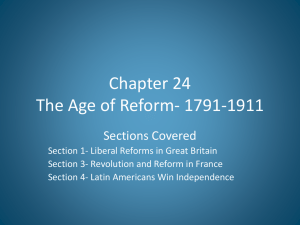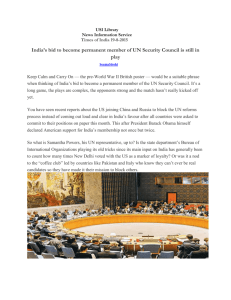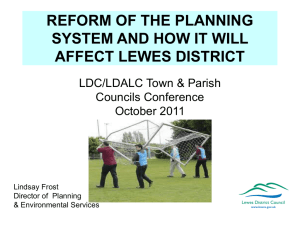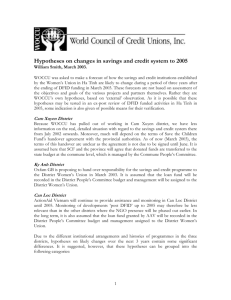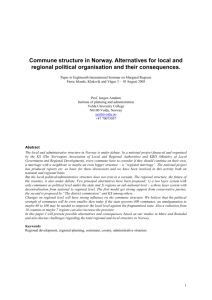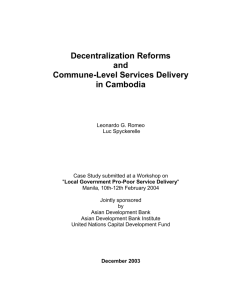Comparative analysis system of local governments in Britain and in
advertisement
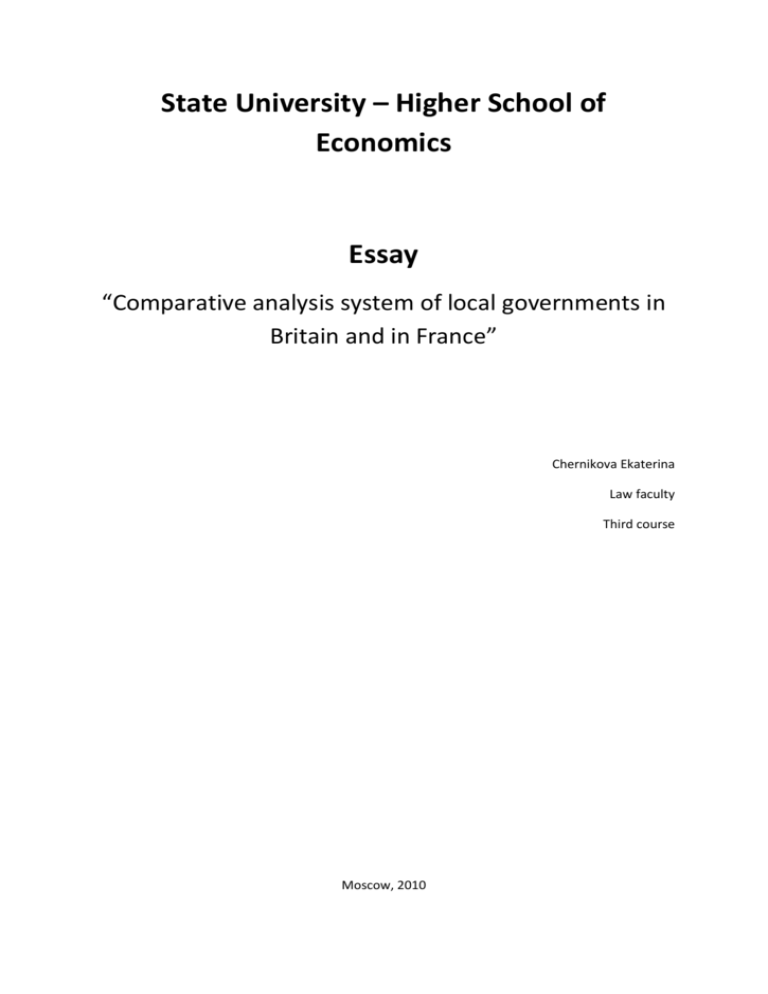
State University – Higher School of Economics Essay “Comparative analysis system of local governments in Britain and in France” Chernikova Ekaterina Law faculty Third course Moscow, 2010 The purpose of this essay to put the reform waves which Great Britain’s local government has seen the late 1970s into a comparative international perspective. The article considers Great Britain and France. The consideration underlying this selection is that in many comparative accounts these two countries are seen as representing, at least in their historical evolution, distinctly different local government systems, so that analysis of their more recent developments should provide insights. The essay is in two sections: firstly, some points on definitions and concepts of local government reform are made. Then, summary accounts of the pertinent reforms are given. Definitions and concepts Reforms of Political and Administrative Institutions Our essay will treat the reforms of political institutions of local government as well as the administrative structures, because only if these two sides of the local government “coin” are seen together can an adequate picture of the ongoing changes be expected. “Traditional” and NPM-Guided Reforms In the analysis which follows a distinction is made between ‘traditional reforms’ and reforms which are rooted in New Public Management (NPM) ideas. Such distinction is more useful because it permits us to obtain a differentiated picture of the varied approaches and components (issues) of past and modern reforms. Traditional reforms were performed in 1960s and 1970s in “Western” countries. They were essentially meant to strengthen the political and administrative institutions. In their political orientation the reforms were managed at supplementing the rights and opportunities of local citizens to influence, and participate in local decision-making. In their administrative issues different measurements can be described: - - - In vertical issue a further distinction can be made between decentralization (elected and politically accountable local government units), and deconcentration ( transfer administrative functions to a lower administrative level). Another important issue of administrative reform of local governments is territorial reforms, which are meant to put local government functions on territorially more viable ground. Reforms of administrative structure include thrust of management concepts and instruments. New Public Management – inspired reforms are rooted in connective of various concepts. The NPM philosophy prescribes post-performance assessments and new forms of process management. It emphasizes the absolute and relative importance of competition, which includes both contests for contracts within the public sector (including the use of quasi-markets) and competition between public and private sector bodies. It advocates the use of competitive mechanisms, with rewards for staff linked to relative performance.1 In following sections, country study will be given, of the two selected countries (Great Britain and France). Great Britain Historically, we can divide Great Britain’s local government system into four periods. Thirst period. England’s local government, following the historic Municipal Corporation Act of 1835, was still characterized by “a plethora of single purpose agencies managed by boards that were appointed or elected in various ways” (Schelcher, 2003:10). It was through the secular reforms of 1888 and 1894, that the territorial basis of England’s modern two-tier local government structure was put in place that persisted until the 1970s. The local councils exercised their political and administrative functions through government by committees. Thus, well into the early twentieth century , England experienced the “ golden ages of local self-government” and presented a type of politically strong and multi-functional local government unparalleled elsewhere in contemporary Europe. Second period. Since the 1920s the Victorian model of local self-government has undergone continuous change as central government. In the course of the 1940s, English local government experienced a sequence of dramatic shifts in range and composition of its responsibilities. The historical multi-function model of local government was significantly curbed. In a major territorial reform, in 1972, the counties were redraw and the number of district was cut. Third period. Since the 1980s, the English local government system has been changed by two waves. The first of these was performed after 1979 when the Conservative government under Margaret Thatcher took office. Two main conceptual thrusts pursued by central government can be discerned (centralized system and market-tasting policy). Fourth period. After office in 1997, the New Labour government under Tony Blair pursued two different tracks (development of NPM system and revitalize Victorian local government system). In sum, the main directions which English local government reforms have taken in the past 25 years can be summarized like this: 1. The centralization which was triggered by Tory government has hardly abated under the New Labour government, and has been transferred to “performance management” 2. The multi-function scope for action of traditional elected and politically accountable local government has been reduced, while the scope of non-elected single prpose actors as well as private single purpose service providers has expanded. The consequence is transition from unitary to a multiple system for governing local communities – from local government to local governance. 1 Here we encounter an inbuilt tension, as these aspects of NPM may conflict with increased control by executive politicians. The use of quasi-contracts opens up control systems to participation by the users of services, and involving private actors in the systems broadens out the actors involved in provision of services to include bodies that are not publicly owned. 3. Initiatives have been undertaken by New Labour government to revitalize the political model of local government by providing new institutional arrangements for effective local political leadership and to instill some new localism. France Local government in France has a long history of centralization; the past 20 years have brought some radical changes. At first sight, the system may seem complex: France is one of the few states in the European Union with four tiers of government - the state or central government, region, department and commune. The decentralization law of 2 March 1982 and the legislation completing it marked the Paris government’s desire to alter the balance of power between the state and local authorities (regions, departments and communes). It gave far greater autonomy in decision-making by sharing administrative and budgetary tasks between central and local authorities. Three Tiers of Local Administration In France there are three main tiers of local administration: the commune (municipality), department and region. These are both districts in which administrative decisions made at national level are carried out and local authorities with powers of their own. Legally speaking, a local authority is a public-law corporation with its own name, territory, budget, employees, etc. and specific powers and a certain degree of autonomy vis-à-vis central government.In addition, there are France’s overseas territories and regional bodies (collectivités territoriales) with special status (Paris, Marseille, Lyon, Corsica, Mayotte and Saint-Pierre-et-Miquelon). Commune (or municipality) The commune, which dates from 1789, is the lowest tier of the French administrative hierarchy. There are nearly 37,000 communes, many more than are found in the other countries of the European Union, because in France the term commune is applied to all municipalities whatever their size - 80% of them have fewer than 1,000 residents. This situation has led the government to encourage smaller communes to merge to form urban communities (communautés urbaines) or group together in associations of several communes (syndicats intercommunaux. The mayor has two hats, since he or she is both the commune’s elected authority and the state’s representative in it. As the commune’s chief executive, the mayor carries out the decisions of the municipal council, is the municipality’s legal representative, proposes and implements the budget, ensures the conservation and management of the commune’s natural environment and built heritage and issues building permits. He/she is responsible for various administrative tasks including publicising laws and regulations and drawing up the electoral register. Mayoral acts are unilateral administrative acts, generally orders, whose legality is subject to a posteriori control by the courts when they are issued by the mayor as the commune’s chief executive and to the approval of the prefect (see below) to whom the mayor is subordinate when acting in the capacity of the state’s representative. Department There are 100 departments in France, 96 in metropolitan France and four overseas (Martinique, Guadeloupe, Réunion and French Guiana). Established in 1789, the department has developed from a partially decentralised local authority to one with full powers of its own (since 1982). It has played a prominent role in the country’s administrative and geographical organisation. The department essentially has competence in health and social services, rural capital works, departmental roads, and the capital expenditure and running costs of collèges. Region France has 26 regions, 22 in metropolitan France and four overseas. The latter have a special status, being at the same time departments and regions. Created in 1955 to provide a framework for regional town and country planning, the region became a local authority in 1982. Its main spheres of competence are planning, regional town and country planning, economic development, vocational training, and the building. The decision-making organ is the regional council whose members are elected for six-years. They are assisted by an economic and social committee, which is a consultative assembly made up of representatives of businesses, the professions, trade unions and other employees’ organisations, regional voluntary organizations. This committee must be consulted on the preparation and implementation of national plans, the establishment of the regional development plan and the major guidelines for the regional budget. The committee is also free to comment on any regional matter or, at the initiative of the regional council’s chairman, any economic, social or cultural proposal. The regional council chairman, elected by the councillors, is the region’s executive authority. His/her responsibilities are identical to those of the general council chairman in the areas within the region’s sphere of competence. Permanency and Change in French Local Authority Administration Article 72 of the Constitution stipulates that the republic’s local authorities ("territorial units") "… shall be self-governing through elected councils", and the 1982 reforms did not change this. The principles of independent administration by local authorities and the election of the members of their decision-making bodies remain the fundamentals of French local government.


